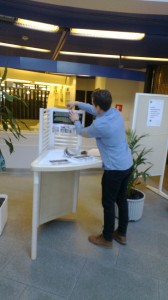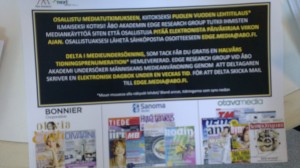Technology and innovation are perceived as one of the biggest drivers in economic- and social transformation as well as in consumer behavior changes. Drawing from our previous blog post written by Niklas (available here) about the PESTC-model, people’s ways to social interaction are changing drastically and the main reason to this is technology.
The distribution of media to several different technological platforms is changing the way people consume media. Presenting some simple statistics from Finland, in 2011 Q2, 67% of the Finnish households owned a portable computer, 42% of the Finnish population owned a smartphone and surfing the internet via mobile phones in 3G networks had tripled in two years. 76 % (Q2 2011) of the Finns had read newspapers on the web and in the beginning of 2012 Finland had approximately 170 000 tablet owners, yet increasing and contributing to changes in consumer behavior. The first crucial step in order for the media industry to adapt to the changes taking place is to deepen their knowledge in the consumers’ media usage/consumption behavior and habits. What media is being consumed? How is it consumed; by print, computer, mobile, TV, radio, tablet or other? How much time does the consumer spend on a particular media? Why is a particular media being consumed; for news read, entertainment, other? These are the main questions we within the EDGE Research Group try to find answers to in terms of the Personal Media Day (PMD) research project, part of this year’s Next Media program. How we have done this in practice is the theme of this times blog post.
Diary and survey as methods for data collection
If and when the researcher is interested in relatively precise measures about how often, how long and in which order a person is doing different activities, the researcher should consider research diaries as a method for collecting data. A research diary is in practice, exactly what one understands with the word diary. They can be completely unstructured, or they can be written following some guidelines (e.g. by always answering a certain set of questions, or looking at a phenomenon through a distinct viewpoint. As a more engaging method, a diary can also give more valid and reliable data than, for instance, a survey. These are also the reasons why we chose electronic diaries as method for data collection.
We gave the respondents some questions to answers, but in addition to that, it was up to the respondents in writing a diary in the format they found most suitable. We instructed the respondents to write a diary about their media usage during one week with the questions presented under the first section in mind (i.e. what media is consumed, how it is consumed (print, PC, laptop, smartphone, tablet etc), for how long, and why). Furthermore we asked the respondent to divide his/her day into three parts; morning, day and evening. In this way we can figure out how media usage differs at different times of the day. At the same time, the media day was made more graspable for the respondents as the day was divided into smaller pieces. The diary could be done by a text editing program or a blog.
At the time of writing we’re starting to have all of the diaries collected and in order to get data about the demographics of the respondents we’ve also sent the sample group a background survey. In addition to the diary, a survey was used to collect values and attitudes concerning media usage, estimated expenditure on media and product ownership.
Recruiting respondents
To get a representable sample, with people from various backgrounds and from different age groups, i.e. a more random sample, we have used different techniques for recruiting. Libraries functioned as the primarily spot for recruiting because we considered libraries effective in reaching people from various demographics.
The libraries also turned out as successful channels for recruiting. For one day I together with Niklas recruited people at the city libraries of Turku and Tampere. The recruiting was backed up by recruiting materials as flyers and posters spread over the libraries and by a note on the website of the city library of Turku.

The latter (static notes) proved out to be more effective. Can’t figure out why, must have been Niklas’ unpolished shoes, or my bad sense of humor? The recruiting material was then available at the libraries for a couple of weeks and evidently this succeeded in capturing attention and spreading the word as we have respondents all the way to Lapland. We also attended a morning gathering at Åbo Katedralskolan to present our study and to recruit younger attendants. Materials were also handed out to Luostarivuoren Lukio (Turku) and Pargas Gymnasium (all three upper secondary schools).
What’s next?
With summer around the corner, we’re starting to see glances of the sun also here at Åbo Akademi University, School of Business and Economics. This applies as well for the PMD research project. The data gathering phase is over and next up is the analyzing of the data. A quick overview on the gathered data you can identify that oh yes, media usage can in many cases be a complex behavior with various media used simultaneously and on different platforms. However, you also can see patterns of typical media days as media usage often tend to follow a routine- the print paper and TV routine has transformed to its 21st century equivalent. Needless to say, media usage differs a lot depending on demographics. Looking forward to start plough through this media jungle. We will have the final results by the next PMD seminar in June. Till then we at EDGE Research Group want to sincerely thank all of our participants, respondents and cooperation partners.
Until next time, have a nice spring and “Glada Vappen”!
Ron Lindqvist
